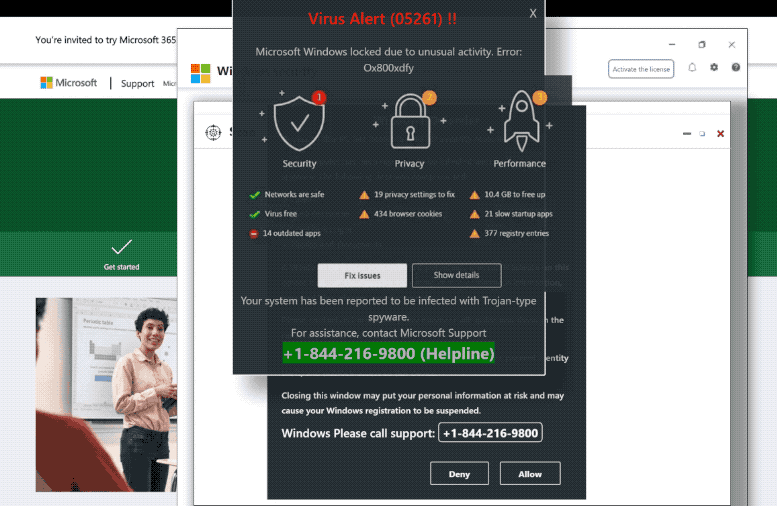What is the “Virus Alert (05261)” scam
“Virus Alert (05261)” is a fake virus alert that claims your computer has been locked due to unusual activity and a supposed malicious infection. The fake alerts ask that users call the provided phone number to get assistance, which is why it’s classified as a tech support scam. Users can ignore the alert as there is no malware on their computer nor has their device been blocked.
The websites that display this “Virus Alert (05261)” scam are made to closely resemble an official Microsoft site. This is done to make the scam seem more legitimate. Immediately upon entering the site, you will get several pop-ups. The pop-ups will claim that issues have been detected on your computer, including outdated apps. One of the pop-ups will also claim that your computer is infected with malware. To supposedly remove the infections and unlock the computer, the pop-up insists that users call the shown number.
Tech support scams are called that because they show fake phone numbers for supposed technical help. The phone number promoted by this particular “Virus Alert (05261)” tech support scam is +1-844-216-9800. If you were to call the number, you would be connected to professional scammers, pretending to work for Microsoft. The scammers have a script they act out, and the act usually begins with the scammer explaining that the computer is infected with a serious malware infection. The scammer offers to remove the infection via remote connection. If you allow the malicious actor this access, they will put on a show of removing the malware but will also steal personal files and even change the device’s password to prevent access.
When scammers have completed their script, they ask for payment for the services users supposedly received. This may not be mentioned in the beginning so users may be taken by surprise. Usually, scammers ask that users pay several hundred dollars. Because you neither received nor actually needed the services, it would be a complete waste of money to pay. If users refuse to pay, scammers can get quite aggressive and start threatening users.
For future reference, keep in mind that virus alerts that appear in your browser will never be legitimate. You should only trust an anti-malware program to provide accurate information about infections on your computer. It’s also worth mentioning that legitimate alerts will never display a phone number.
Virus Alert (05261) !!
Microsoft Windows locked due to unusual activity. Error: 0x800xdfy
Security
Networks are safe
Virus free
14 outdated appsPrivacy
19 privacy settings to fix
434 browser cookiesPerformance
10.4 GB to free up
21 slow startup apps
377 registry entriesFix Issues Show details
Your system has been reported to be infected with Trojan-type spyware.
For assistance, contact Microsoft Support
+1-844-216-9800 (Helpline)
Why am I redirected to the “Virus Alert (05261)” pop-up scam?
Users can get redirected to tech support scams either because of adware or because they browse high-risk websites. A lot of websites are classified as high-risk because of the ads they expose users to and the redirects they trigger. Sites with pornography or pirated content are particularly guilty of this because they redirect users when they click on anything. However, both intrusive ads and random redirects are easily preventable with any decent adblocker program.
Redirects to the “Virus Alert (05261)” pop-up scam and similar ones can also be a sign of an adware infection. Adware is a minor infection but is very annoying because it triggers redirects and ads. Adware and browser hijacker infections are generally installed via the software bundling method. The method allows adware and similar infections to be added to free software as extra offers. The offers are set to install alongside the program and do not require explicit permission from users. These offers are technically optional but to stop them from installing, they need to be manually deselected. However, the offers are hidden in settings users don’t usually use, which is why most users do not even notice the offers.
If you want to prevent these unwanted installations, you need to pay attention when installing programs. Specifically, you need to choose Advanced settings when given the option. The installation window always recommends using Default (Basic) settings but if you use them, all added offers will be permitted to install alongside. Unless you want to fill your computer with junk programs, use Advanced settings when installing programs. Advanced settings will clearly show what has been added, and you will have the option to deselect the offers you do not want. We always recommend deselecting all offers because no legitimate program will use this method. Many anti-virus programs detect programs that use it as potential threats.
“Virus Alert (05261)” pop-up scam removal
If this pop-up appears on your screen, just close the window and that will remove “Virus Alert (05261)” pop-up scam from your screen. If you cannot close the window, force closing the browser should work. To prevent redirects to sites that display tech support scams in the future, install a good adblocker program if you don’t already have it. And if you get redirected regularly, we strongly recommend scanning the computer with WiperSoft to check for an adware infection.
Site Disclaimer
WiperSoft.com is not sponsored, affiliated, linked to or owned by malware developers or distributors that are referred to in this article. The article does NOT endorse or promote malicious programs. The intention behind it is to present useful information that will help users to detect and eliminate malware from their computer by using WiperSoft and/or the manual removal guide.
The article should only be used for educational purposes. If you follow the instructions provided in the article, you agree to be bound by this disclaimer. We do not guarantee that the article will aid you in completely removing the malware from your PC. Malicious programs are constantly developing, which is why it is not always easy or possible to clean the computer by using only the manual removal guide.

